At the very moment, Barcelona find themselves in a rather tricky situation that just might take all of Quique Setien’s ingenuity to solve. Luis Suárez, the team’s certified first-choice no.9, has undergone surgery and will likely sit out the remainder of the season or, at the very best, make a glorious return at the very end of La Liga.
This was a huge blow for the Catalans but when it rains, it pours, and for the Blaugrana, it’s definitely pouring because Ousmane Dembélé has also been ruled out for the remainder of the campaign and has undergone surgery himself following a relapse during his recovery period.
The young Frenchman can’t catch a break and now with two of the big pieces up front sidelined by fitness issues and with the club selling both Carles Pérez and Abel Ruiz in the January transfer market, Barcelona find themselves rather thin in that compartment.
As things currently stand, their only choices are Lionel Messi, Antoine Griezmann and the 17-year-old Ansu Fati and while they might form a formidable trio in the forward line, with no rotations or substitutes available, it could become a tall task even for players of their quality and pedigree.
Needless to say, Setién will have to work out how to work around this huge discrepancy up front and somehow make up for it through other sources if he is to compete with Real Madrid and co. The next best choice he has is mobilising the midfield and giving them more attacking and aggressive tasks on the pitch.
We’ve seen the first result with the likes of Frenkie de Jong being pushed higher up the pitch and Arturo Vidal getting a much bigger role in the team altogether. But which of his midfielders have the tools to mitigate the loss of Suárez and contribute most to the attack?
This data analysis will use statistics to highlight Barcelona’s midfielders’ attacking properties and use analysis to recognise ideal candidates for such a task.
The initial data check
It’s difficult for midfielders to successfully replicate a striker’s numbers or even come reasonably close to them. And this is especially true for Barcelona since their midfielders have to be keen build-up machines and usually, their style and skillsets will match entirely different needs of the team.
But times are tough over at the Catalan capital and highly technical players and creators from the deep will have to adjust to a different role if Barcelona are to survive this tough period. With that in mind, we’ve consulted Wyscout’s database to see which of the players suit the more aggressive and attacking-minded role Setién might have to enforce for the remainder of the season.
Some of the main metrics we’ve used are as follows: expected goals (xG), expected assists (xA), successful attacking actions, shots per 90 minutes, dribble success in %, touches in the box and progressive runs made per game.
One thing has to be noted before we delve into the numbers: Sergio Busquets has been discarded from the equation since he is unlikely to get an attacking role in the team and his numbers in that department are not relevant to the data analysis.
With that being said, here’s the initial data analysis of the remainder of the midfield crop Setién has at his disposal: De Jong, Vidal, Sergi Roberto, Arthur Melo, Ivan Rakitić and Riqui Puig.
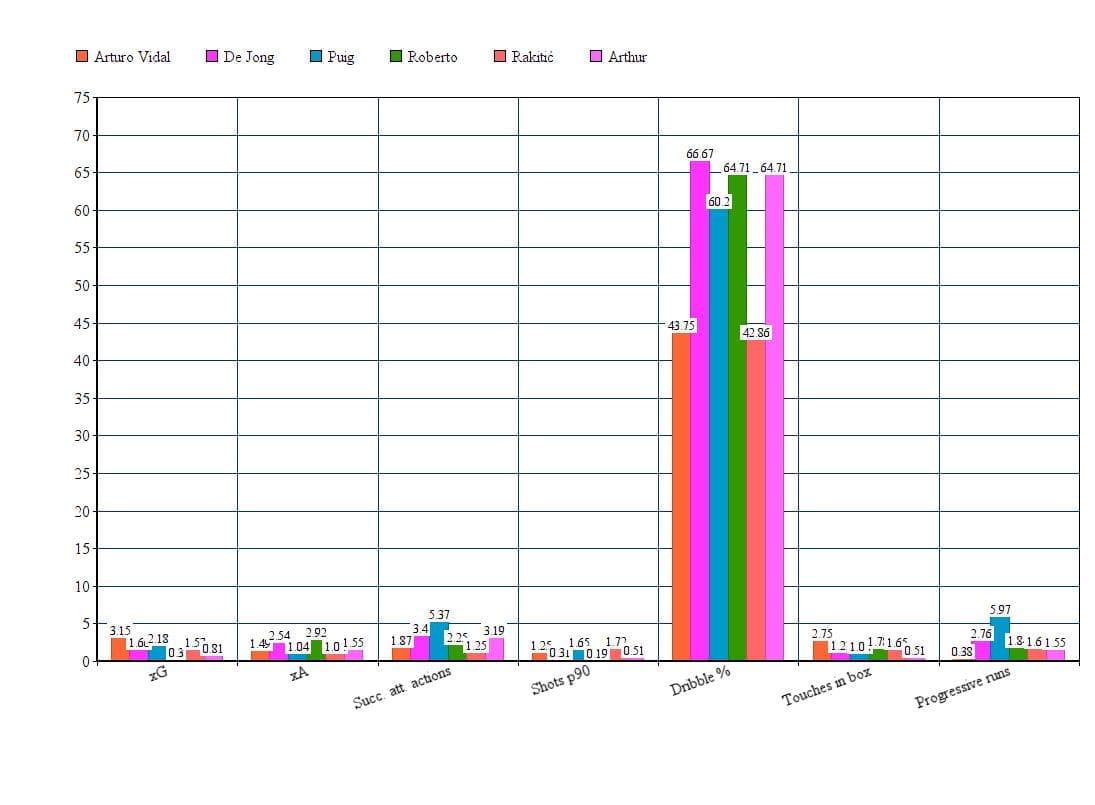
At first glance, every player stands out for different metrics and this will undoubtedly make Setién’s job that much more difficult. It should also be noted that the data is somewhat skewed by the actual game time of the players.
Some of them, like De Jong, have practically played all the available minutes while Puig, for example, is on a relatively small sample that also draws stats from Barcelona B. But nonetheless, the results do give us a fairly accurate depiction of their player profiles and whether they suit the needs of Setién’s current tactics.
This data analysis will now go through each of the players, highlighting their attacking stats and seeing what is it that they bring to the table.
Frenkie de Jong
The young Dutchman has been chosen as Setién’s pick for the attacking midfielder role even though we’re not really used to seeing him there. Let’s see why that actually is and whether the coach’s choice is actually warranted. De Jong has so far scored two goals for Barcelona in La Liga but his attacking metrics are also quite impressive.
In terms of xG, he ranks third among the six midfielders with a total value of 1.66 and two goals scored, only behind Vidal and Puig. But the Dutchie is also quite good in terms of xA as he averaged 2.54 so far. Only Roberto has more.
De Jong is also second-best in terms of successful attacking actions (3.4) and progressive runs (2.76) while he’s the best dribbler out of the six midfielders. However, it is a slight concern that he’s only taking 0.31 shots per 90 minutes and if Setién is going to play him up high, maybe this number will have to rise significantly.
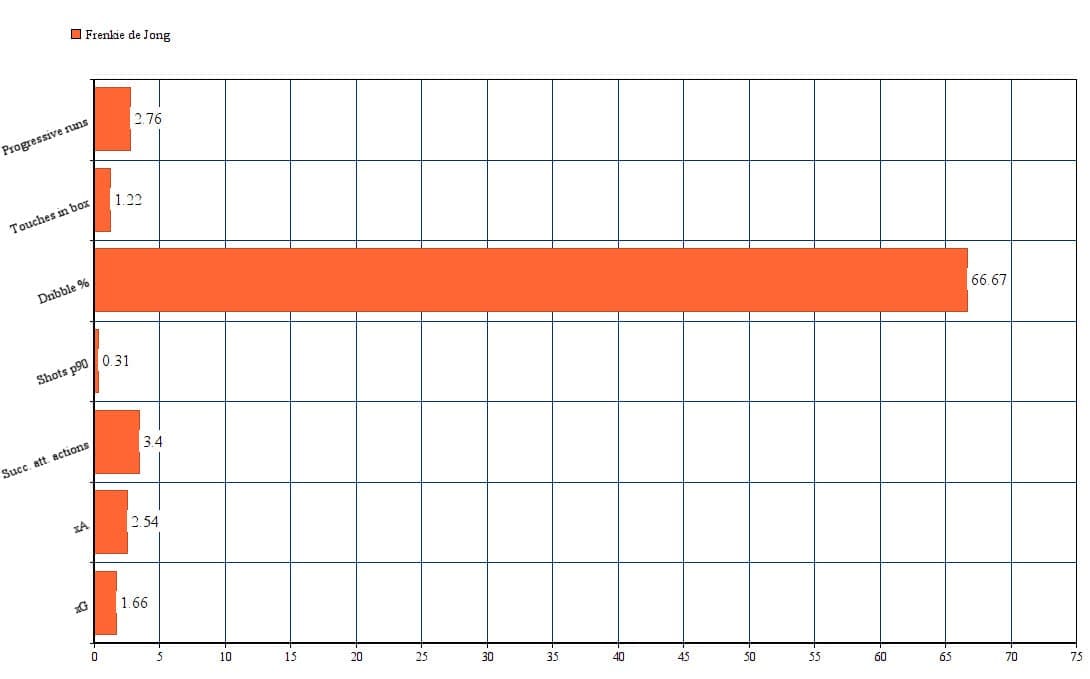
Arturo Vidal
Another man whose role in the team has changed drastically since Suárez’s injury but it’s not really that Vidal is being used in a different way but rather, he’s been used far more often and has actually become a crucial piece of Barcelona’s attack. Let’s see why that’s so.
Out of the six midfielders on this short-list, the Chilean international averages the highest xG values (3.15) and the most touches inside the opposition’s box (2.75). This does indicate that he is the one getting closest to the opposition’s goal when he’s on the pitch.
He’s also taking 1.25 shots per 90 minutes but his dribbling success is second-worst with 43.75% and he’s lagging behind in xA, progressive runs and overall successful attacking actions. By all accounts, he’s a good presence in the final third that can distract the markers and create space but is not really the one to orchestrate himself.
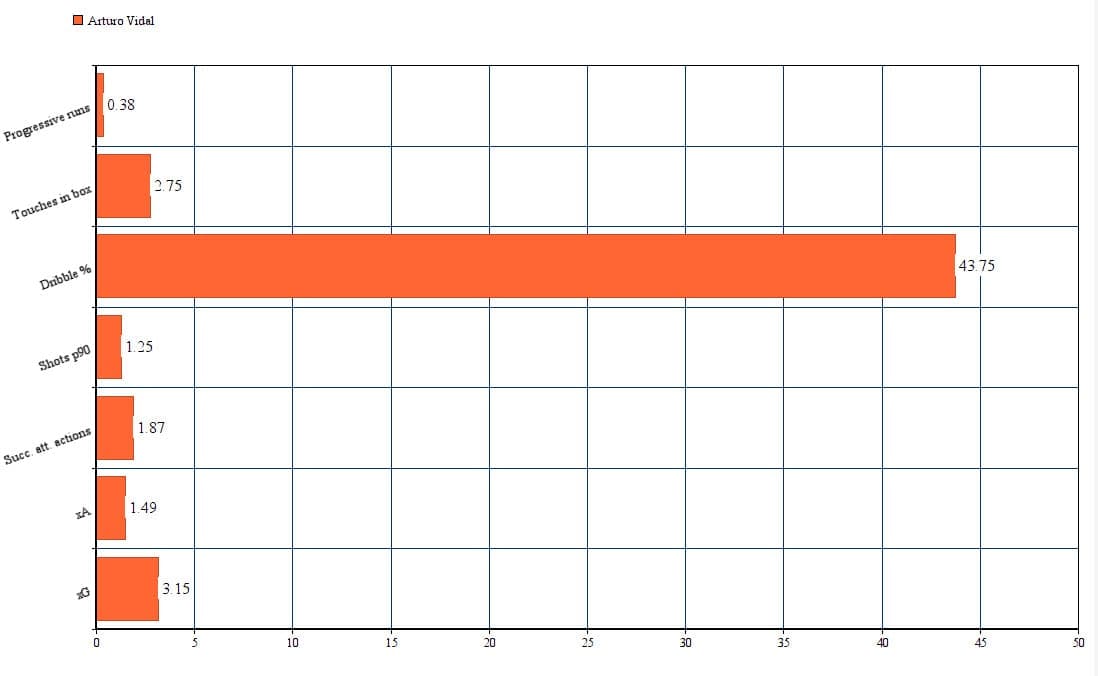
Ivan Rakitić
The Croat has been slightly out of favour for a while now at Barcelona but his attacking metrics are still comparable to his teammates. Out of all six midfielders, Rakitić is the one who shots most often (1.72 per 90) and his xG value of 1.57 means he misses out on the top three very narrowly behind De Jong’s 1.66.
But when it comes to the rest of the metrics, Rakitić seems to be more alike to Vidal, as he shoots often and averages 1.65 touches in the box but his final output in terms of xG and xA are not on the desired level.
At this point, the Chilean seems like a better option of the two despite their profiles offering similar attributes on the pitch.
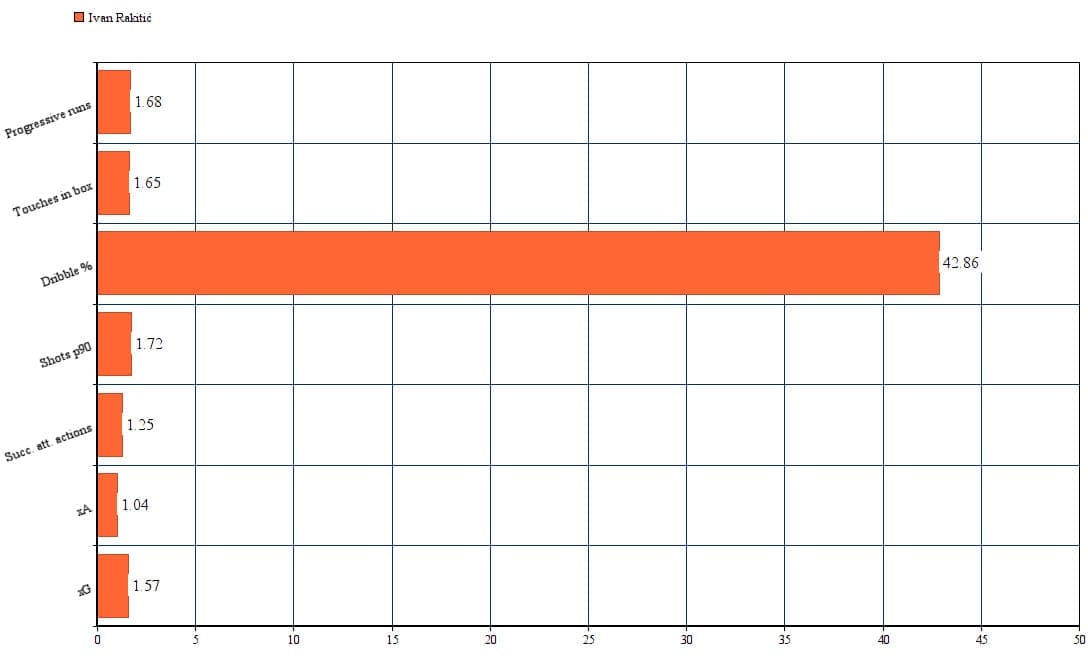
Sergi Roberto
Roberto is very much the Swiss knife of this Barcelona squad and Setién has deployed him as the right-winger on multiple occasions in recent times. The Spaniard’s high dribbling success and incredible xA figures make him a great fit for the wider role that aims to supply his teammates in the box.
Roberto also completes a lot of attacking actions on average and due to his high positioning, he’s often inside the box as well. But his xG is basically non-existent and stands at 0.3, which is the lowest of all six by quite a margin. Similarly, he rarely shoots on goal and 0.19 shots per 90 mean he’s rarely the danger man for the opposition himself.
Still, there’s certainly an argument to be had for his inclusion in the starting lineup but it does seem like a more conservative option since Roberto can drop into the midfield and cover the right side as well burst forward when needed.
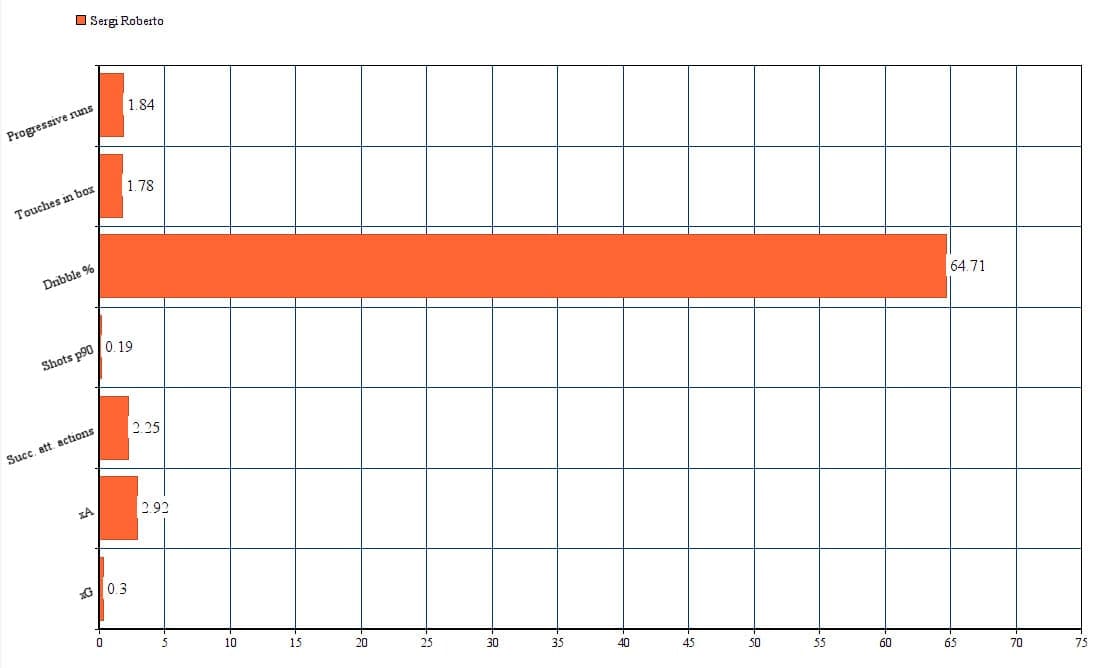
Arthur Melo
The Brazilian is looking like a player capable of solidifying a place in the starting XI as soon as his fitness issues disappear. Arthur has impressive attacking figures to back up his potential inclusion and offers a dose of stability and control through possession.
Even though he doesn’t top any of the metrics used for this data analysis, he is tied in second in dribble success (64.71%), third in successful attacking actions with 3.19 and third in xA with 1.55.
His weaknesses seem to be shooting and finishing as both categories have him near the bottom.
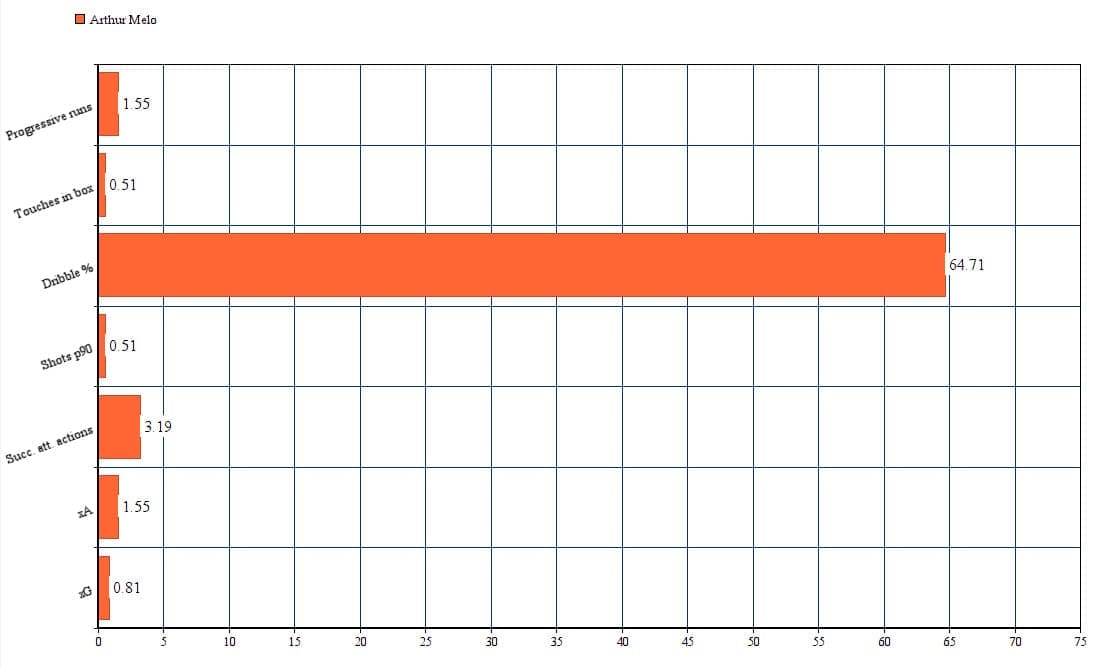
Riqui Puig
The last but not the least of the picks in any regards is Barcelona’s own La Masia prodigy Puig. Interestingly enough, and with a small disclaimer in regards to game time we’ve mentioned before, the young midfielder actually looks like a great choice Setién shouldn’t be afraid to try out.
Puig is actually topping the charts with progressive runs (5.97) by a distance and is second in both xG and shots per 90 values (2.18 & 1.65 respectively). So he can carry the ball into the final third and is a direct threat to the opposition either by shooting or getting himself into good scoring opportunities.
He also has the dribbling to control the ball and potentially create chances within those compact blocks Barcelona so often face. In fact, Puig looks more than just decent across the board and in all the metrics and it does surprise that he is not picked more often than he actually is.
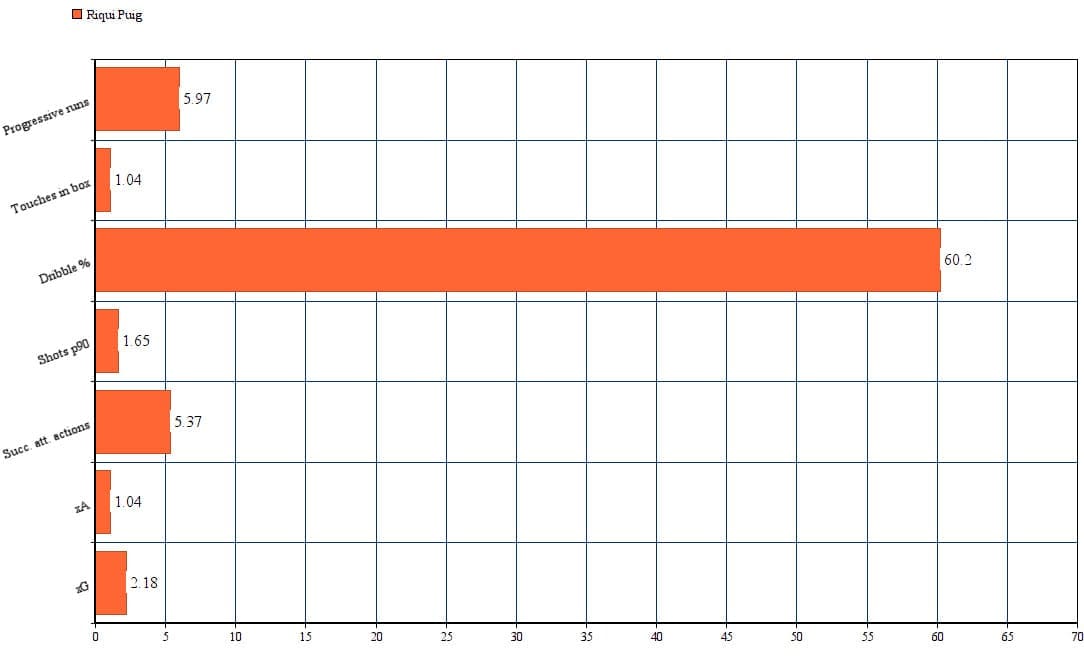
Final remarks
It’s very difficult to actually go through the midfield options and say for sure who should Barcelona pick alongside whom. All of them have different strengths but it’s interesting to see what they actually excel at and what should be improved for the team’s current needs.
Puig definitely looks like someone Setién should look at far more often while Vidal is the ‘necessary evil’ in the finely-tuned and highly technical Barcelona midfield. De Jong’s figures are also quite impressive and he seems to be a natural pick despite never playing in such a role before.
Arthur is another well-rounded player but his final output and lack of aggressiveness in either positioning or shooting make him a slightly worse choice. Rakitic and Roberto do have their strengths but still fall behind the rest of the midfield crop.






Comments